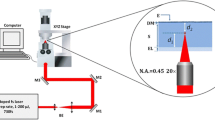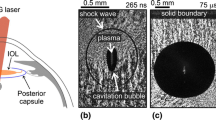Background: The characteristics of shock waves during photoablation were investigated for an IR and a UV laser. These stress waves may be harmful to ocular structures.
Material and methods: The amplitude of shock waves was measured by a needle-shaped hydrophone in enucleated porcine eyes during excimer laser (193 nm, 23 ns, diameter of ablation 1.5 – 7.5 mm) and Er:YAG laser photoablation (2.94 µm, 200 µs, 1.2 mJ/cm2, diameter of ablation 4 mm).
Results: With the excimer laser at ablation zones larger than 4.5 mm, a pressure focus occurs at a distance of 4 – 6 mm behind the cornea. The pressure amplitudes are smaller than 80 bar for a fluence of 180 mJ/cm2 and decrease steadily to values below 10 bar towards the retinal level. Higher fluences produce higher pressure values; in the range of 60 to 220 mJ/cm2 the relation is linear. For the Er:YAG laser, pressure amplitudes are smaller than 0.5 bar.
Conclusions: Mechanical damage of the retina is unlikely during excimer- or Er:YAG-laser ablation. The existence of a pressure focus may result in mechanical damages of the posterior lens or anterior vitreous at large ablation diameters. During Er:YAG laser ablation, shock waves could not be detected with our measurements. Theoretical estimations yield values of less than 700 mbar at a fluence of 1.2 J/cm2. The pressure load of the endothelium is independent of diameter but dependent on fluence.
Hintergrund: Die Ausbreitungscharakteristik der Druckwelle nach Photoablation der Hornhaut soll für einen IR- und einen UV-Laser in Abhängigkeit vom Ablationsdurchmesser, vom Abstand hinter der Hornhaut und von der Energiedichte untersucht werden. Diese Druckwellen können schädlich für manche intraokularen Strukturen sein.
Material und Methode: An enukleierten Schweineaugen wurde bei der Photoablation mit einem Excimerlaser (193 nm, 23 ns, Ablationsdurchmesser 1,5 – 7,5 mm) und mit einem Er:YAG-Laser (2,94 µm, 200 µs, 1,2 mJ/cm2, Ablationsdurchmesser 4 mm) die Amplitude der Druckwelle mit einem piezoelektrischen Nadelhydrofon gemessen.
Ergebnisse: Beim Excimerlaser bildet sich bei einem Ablationsdurchmesser >4,5 mm ein Druckfokus im Abstand von 4 – 6 mm hinter der Hornhaut aus. Bei einer Energiedichte von 180 mJ/cm2 liegen die Druckwerte im Mittel alle <8 ⋅ 106 Pa. Sie verringern sich stetig in Richtung Netzhaut bis unter 106 Pa. Höhere Energiedichten ergeben höhere Druckwerte, wobei der Zusammenhang im Bereich von 60 – 220 mJ/cm2 linear ist. Die Druckamplituden beim frei laufenden Er:YAG-Laser liegen <5 ⋅ 104 Pa.
Schlußfolgerungen: Eine mechanische Schädigung an der Netzhaut ist beim Excimerlaser und Er:YAG-Laser unwahrscheinlich. Das Vorhandensein des Druckfokus bei großen Ablationsdurchmessern beim Excimerlaser könnte zur mechanischen Schädigung der Linsenkapsel führen. Beim Einsatz des Er:YAG-Lasers ließen sich mit der vorhandenen Meßempfindlichkeit keine Drucksignale detektieren. Theoretische Abschätzungen ergeben Werte <7 ⋅ 104 Pa bei einer Energiedichte von 1,2 J/cm2. Die Wirkung der Druckamplitude auf das Endothel ist unabhängig vom Durchmesser, aber abhängig von der Energiedichte.
Similar content being viewed by others
Author information
Authors and Affiliations
Rights and permissions
About this article
Cite this article
Spörl, E., Gruchmann, T., Genth, U. et al. Laserinduzierte Druckwellen am Auge Ausbreitungscharakteristik*. Ophthalmologe 94, 578–582 (1997). https://doi.org/10.1007/s003470050162
Issue Date:
DOI: https://doi.org/10.1007/s003470050162




